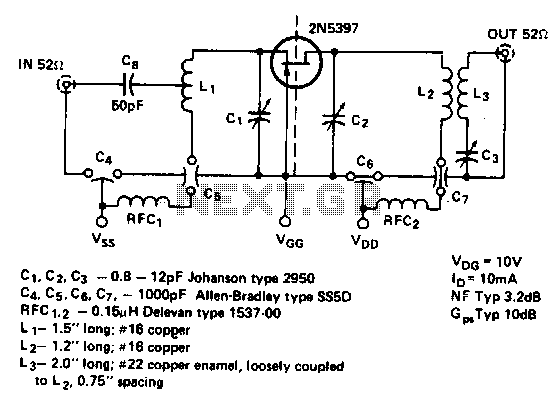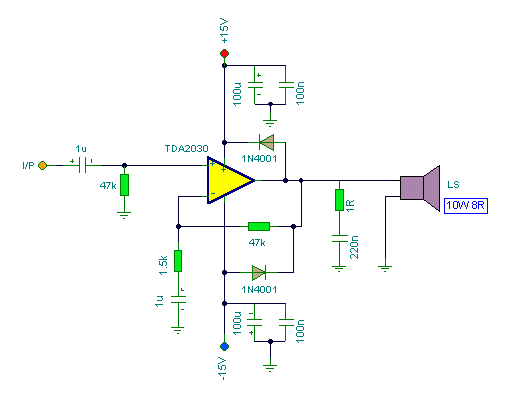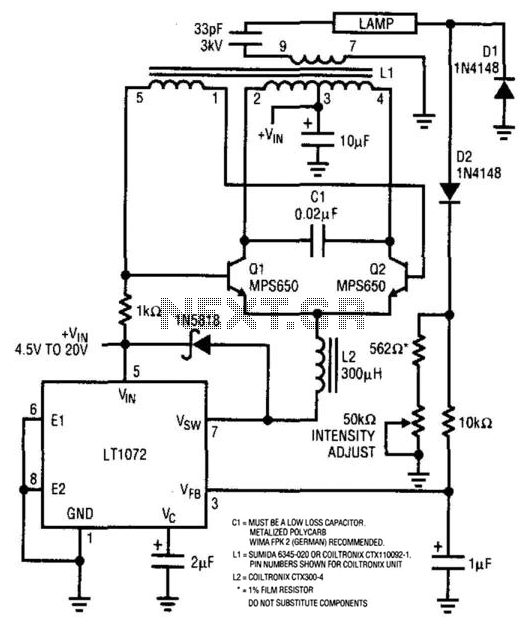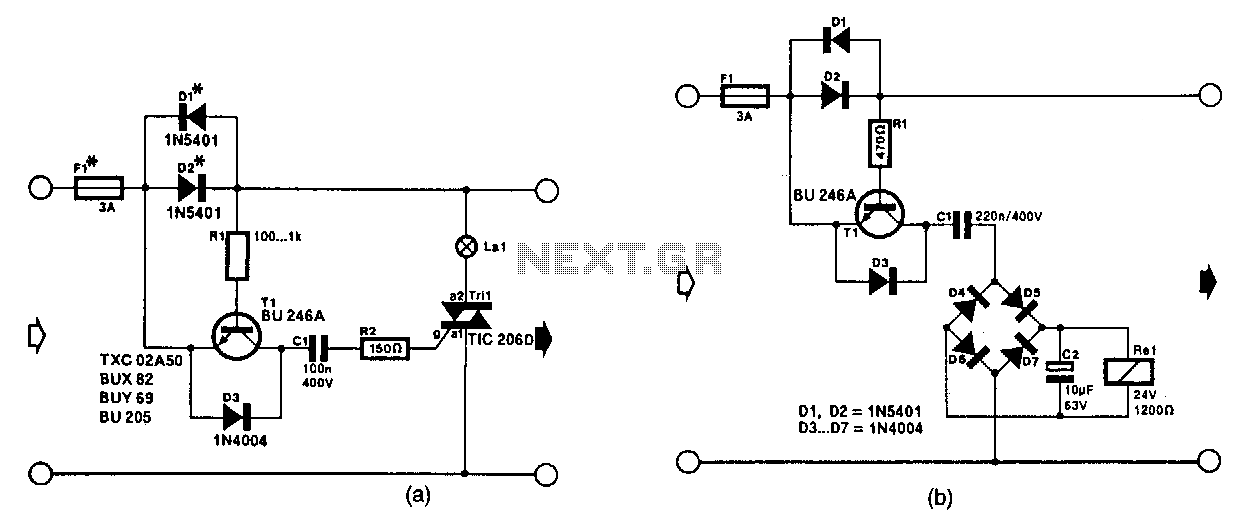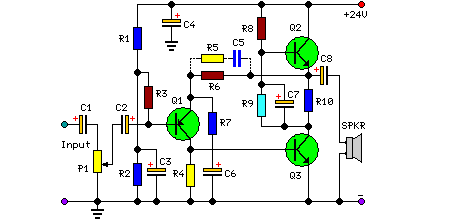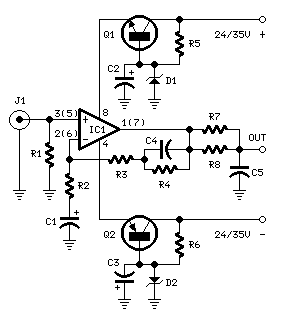
headphone monitor amp
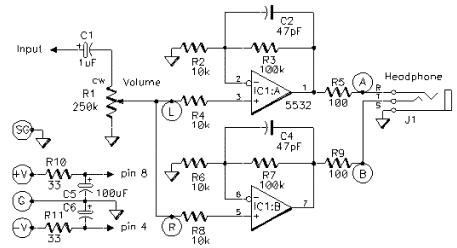
This simple amplifier is designed to add a headphone jack to equipment that does not have this feature. The Headphone Buffer circuit board is compact (1.2" x 1.4"), allowing it to fit into even the smallest spaces, and its low power requirements enable the use of existing power supplies in retrofitted devices. It serves as a valuable enhancement to various PAiA products, such as the Submixer or Submix-Master. Incorporating a headphone output transforms a Stack-In-a-Box into an impressive practice amplifier. The primary component utilized is the 5532 Dual OpAmp. This component is selected for its low noise characteristics and its ability to deliver nearly 350mW of output power per channel, which is sufficient for driving headphones. The circuit can operate with bipolar supply voltages ranging from +/-5V to +/-18V, and it is not essential for the positive and negative supply voltages to be of equal magnitude. The excellent supply voltage rejection of the integrated circuit allows it to function effectively with unregulated power supplies. In typical mono applications, such as adding headphones to a FatMan or Theremax, both the left and right inputs of the amplifier are connected to the volume control provided with the kit. For stereo applications, a dual-ganged potentiometer should be employed, and this modification is detailed in the accompanying instructions.
The Headphone Buffer circuit is a versatile and efficient solution for integrating headphone outputs into various audio equipment. Its compact form factor facilitates installation in tight spaces, making it suitable for modifications to existing devices. The use of the 5532 Dual OpAmp as the core component is pivotal, as it not only minimizes noise but also provides substantial power output, ensuring that headphones receive adequate drive levels for optimal performance.
The operational voltage range of the circuit allows for flexibility in application, accommodating different power supply configurations. This feature is particularly beneficial in environments where unregulated power supplies are prevalent, as the circuit can maintain functionality without the need for precise voltage regulation.
In practical implementation, the circuit can be easily integrated into devices like the FatMan or Theremax, enhancing their usability by allowing for headphone monitoring. The inclusion of a volume control ensures that users can adjust the output level to their preference, which is crucial for maintaining audio quality and preventing damage to headphones from excessive volume levels.
For stereo applications, the recommendation to use a dual-ganged potentiometer allows for synchronized volume adjustment across both channels, providing a balanced listening experience. The instructions accompanying the kit provide clear guidance on this modification, ensuring that users can achieve the desired outcome with ease.
Overall, the Headphone Buffer circuit is an essential addition for any audio equipment lacking a headphone output, enhancing functionality and user experience while maintaining high audio fidelity.This simple amplifier is ideal for adding a headphone jack to equipment that lacks this feature. The Headphone Buffer circuit board is small enough (1. 2" X 1. 4") to squeeze into even the smallest spaces and power requirements are so low that existing supplies in retrofitted gear can be used. It`s a useful addition to many PAiA products such as the Submixer or Submix-Master. Adding a headphone output turns a Stack-In-a-Box it into an incredible practice amp. The key component is the 5532 Dual OpAmp. While ordinarily this part is chosen for it`s low noise characteristics, it is also capable of delivering nearly 350mW of output power per side, more than enough to drive headphones. The circuit can operate from bipolar voltages from +/-5V to +/-18V and it is not absolutely necessary that the + and - supply voltages be the same magnitude.
The superior supply voltage rejection of the IC allows operation with unregulated supplies. In the typical mono application such as adding headphones to a FatMan or Theremax, the Left and Right inputs of the amp are both connected to the Volume control supplied with the kit. For stereo applications a dual ganged pot should be used and this modification is covered in the instructions.
🔗 External reference
The Headphone Buffer circuit is a versatile and efficient solution for integrating headphone outputs into various audio equipment. Its compact form factor facilitates installation in tight spaces, making it suitable for modifications to existing devices. The use of the 5532 Dual OpAmp as the core component is pivotal, as it not only minimizes noise but also provides substantial power output, ensuring that headphones receive adequate drive levels for optimal performance.
The operational voltage range of the circuit allows for flexibility in application, accommodating different power supply configurations. This feature is particularly beneficial in environments where unregulated power supplies are prevalent, as the circuit can maintain functionality without the need for precise voltage regulation.
In practical implementation, the circuit can be easily integrated into devices like the FatMan or Theremax, enhancing their usability by allowing for headphone monitoring. The inclusion of a volume control ensures that users can adjust the output level to their preference, which is crucial for maintaining audio quality and preventing damage to headphones from excessive volume levels.
For stereo applications, the recommendation to use a dual-ganged potentiometer allows for synchronized volume adjustment across both channels, providing a balanced listening experience. The instructions accompanying the kit provide clear guidance on this modification, ensuring that users can achieve the desired outcome with ease.
Overall, the Headphone Buffer circuit is an essential addition for any audio equipment lacking a headphone output, enhancing functionality and user experience while maintaining high audio fidelity.This simple amplifier is ideal for adding a headphone jack to equipment that lacks this feature. The Headphone Buffer circuit board is small enough (1. 2" X 1. 4") to squeeze into even the smallest spaces and power requirements are so low that existing supplies in retrofitted gear can be used. It`s a useful addition to many PAiA products such as the Submixer or Submix-Master. Adding a headphone output turns a Stack-In-a-Box it into an incredible practice amp. The key component is the 5532 Dual OpAmp. While ordinarily this part is chosen for it`s low noise characteristics, it is also capable of delivering nearly 350mW of output power per side, more than enough to drive headphones. The circuit can operate from bipolar voltages from +/-5V to +/-18V and it is not absolutely necessary that the + and - supply voltages be the same magnitude.
The superior supply voltage rejection of the IC allows operation with unregulated supplies. In the typical mono application such as adding headphones to a FatMan or Theremax, the Left and Right inputs of the amp are both connected to the Volume control supplied with the kit. For stereo applications a dual ganged pot should be used and this modification is covered in the instructions.
🔗 External reference
